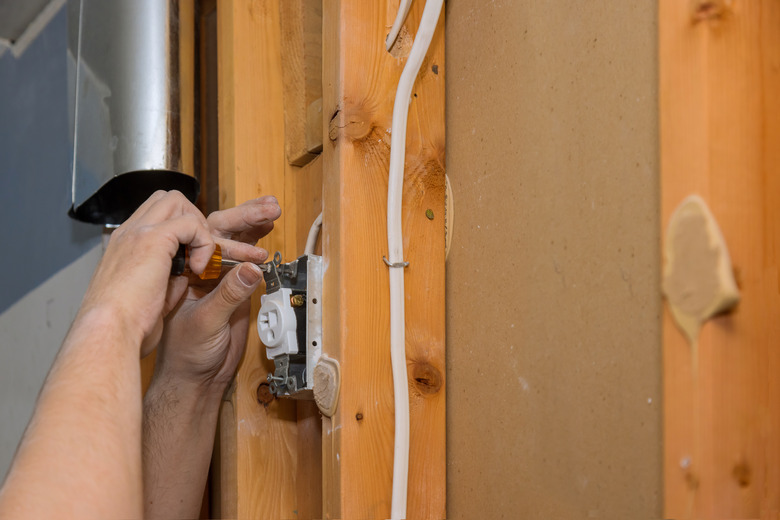How To Change A 2-Prong Electrical Outlet To A 3-Prong
We may receive a commission on purchases made from links.
If you're wondering how to replace a two-prong outlet with a three-prong one, the first thing you need to know is whether the two-prong outlet is grounded, and there's an easy way to tell. If the slots are different sizes, the outlet is polarized, and since polarized outlets were introduced after circuit grounding was an NEC requirement, there's a good chance this one is grounded. If the slots are the same size, however, the outlet probably predates the grounding requirement and isn't grounded.
Changing electrical outlets from two-prong to three-prong without grounding them is dangerous. The third prong is a sign that the outlet is grounded, and if it really isn't, someone who thinks it is could have a nasty accident or damage some expensive equipment. There is an easy way to convert an ungrounded two-prong outlet to a three-prong one that will protect you from shocks, and it doesn't involve rewiring the circuit, but it won't protect your electrical equipment.
Convert a 2-Prong Outlet to a 3-Prong GFCI
Convert a 2-Prong Outlet to a 3-Prong GFCI
Replacing a two-prong outlet with a GFCI outlet (all GFCIs have three prongs) is a safe way to make the conversion. Electricians don't recommend this as an alternative to rewiring the circuit — and all the house wiring if necessary — to ground it and bring it up to code, but it's a far less expensive option and acceptable as a temporary solution.
A GFCI outlet has an internal breaker that detects a current surge as small as 4 or 5 milliamps and trips in less than one-tenth of a second to stop the current flow. That's a quick-enough response to prevent anyone from getting shocked, but it won't prevent damage to sensitive electronic equipment. When you make this change, therefore, the NEC requires you to put a label on the outlet that says "no equipment ground." This label comes with every GFCI.
Remove the Existing Outlet and Prepare the Wires
Remove the Existing Outlet and Prepare the Wires
Before doing any electrical work, it's always important to turn off the circuit breaker controlling the circuit, and you should keep a voltage tester on hand to check wires before you touch them just in case. Unscrew the cover plate, unscrew the outlet from the electrical box, and pull out the receptacle carefully to avoid cracking the insulation on old wiring. Unscrew the terminal screws and remove the wires or if the wires have enough slack, cut them just behind the back of the outlet with wire snippers.
If the wires are short, you may have to lengthen them by twisting on a short length of wire of the same size and wire gauge and screwing wire caps onto the splices. If there is more than one set of wires, these caps will take up room in the box, and a GFCI is bigger than a regular outlet, so test the GFCI to make sure it fits. If not, you're going to have to cut into the wall, remove the electrical box and replace it with a bigger one.
Install the New GFCI Outlet
Install the New GFCI Outlet
Unlike a regular outlet, a GFCI has a dedicated set of terminals for the incoming line circuit and another set for a load going to another outlet, switch, or light fixture. There are labels on the back of the device to mark these terminals. If there is more than one set of wires in the box, you need to identify the line wires, and that may mean turning the breaker back on and testing the wires with a voltage tester. Once you know, turn the breaker off again.
Connect the black line wire to the brass line terminal and the white one to the chrome line terminal. Connect the outgoing wires to the load terminals — black to brass and white to chrome. GFCIs don't have stab-lock holes, so you have to wrap each wire clockwise around the terminal screw after stripping off about an inch of insulation if necessary and then tighten the screw with a screwdriver. Screw the outlet to the electrical box, install the cover plate, turn on the breaker, and push in the reset button. If the button stays in, you're good to go.
